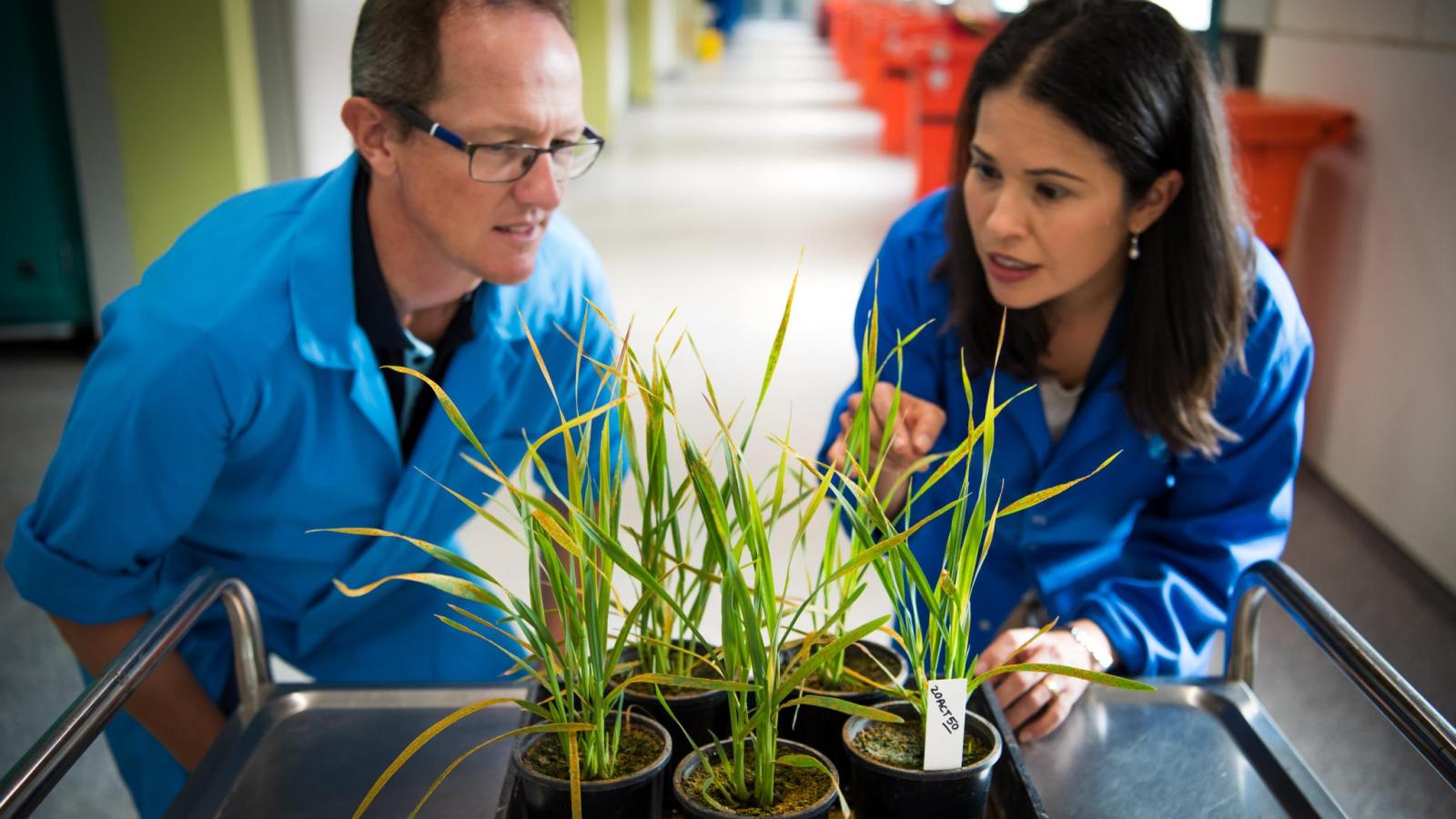We are currently seeking domestic samples of oat crown rust to support our research. Below are some important guidelines for submitting samples.
We welcome any information you can provide, but are particularly interested in:
- Location (state, city); even better GPS or Google Maps Plus Code location
- To obtain GPS/Google Maps Plus Code:
- Desktop: Zoom to precise location, right click to see coordinates in pop-up menu. Left click to copy coordinates to clipboard
- Mobile: Zoom to precise location, create red pin by pressing and holding on location, then tap the pin for an information tab with both GPS and Google Plus Code locations. Tap either one to copy to clipboard.
Rust (leaf rust, stem rust, stripe rust, crown rust)
- Host (wheat, barley, oat, grasses, etc.)
- Cultivar or line name if known
- Severity and prevalence
- Growth stage: when the rust likely arrived, when infection was first noted and current growth stage
- Where rust is found on the plants, e.g., lower leaves, flag leaf, etc.
Guidelines for making cereal rust uredinial collections
- Rust pustules should be fresh and fully developed, except when this may not be possible, i.e., the first uredinial collections found early in the season.
- When rusted small grain or grass plants are encountered, please either (i) cut 5 to 10 sections of plant stem (avoiding plant nodes as they do not readily air dry) or (ii) a leaf section, ~10 cm long with large and small pustules. Place samples in a regular paper mail envelope (Please Do Not use plastic or waterproof envelopes).
Do not staple or tape the sample envelope, instead fold the flap shut. - Important information should be recorded for each collection, e.g., date, location, cultivar or line, crop stage, whether collection is from a nursery or commercial field, etc. If the grass genus or species is unknown to the collector, please send a head in a separate bag or envelope if possible, indicating which collection it is associated with to aid in identification.
- Please avoid exposing samples to direct sunlight or unusual heat of any kind, e.g., car dashboard, outside mailboxes, etc. Samples should be kept at room temperature for 24 hours to allow the plant material to dry. Please do not keep samples in a freezer.
The samples should be sent to us as soon as possible after the samples have dried. If not the samples should be placed in a cooler or refrigerator before they are mailed.
Collate all sample envelopes and collection forms into a larger envelope or package and promptly mail to:
Dr. Melania Figueroa
(attention David Lewis)
CSIRO Agriculture & Food
GPO BOX 1700 Canberra ACT 2601
We are currently seeking domestic samples of oat crown rust to support our research. Below are some important guidelines for submitting samples.
We welcome any information you can provide, but are particularly interested in:
- Location (state, city); even better GPS or Google Maps Plus Code location
- To obtain GPS/Google Maps Plus Code:
- Desktop: Zoom to precise location, right click to see coordinates in pop-up menu. Left click to copy coordinates to clipboard
- Mobile: Zoom to precise location, create red pin by pressing and holding on location, then tap the pin for an information tab with both GPS and Google Plus Code locations. Tap either one to copy to clipboard.
Rust (leaf rust, stem rust, stripe rust, crown rust)
- Host (wheat, barley, oat, grasses, etc.)
- Cultivar or line name if known
- Severity and prevalence
- Growth stage: when the rust likely arrived, when infection was first noted and current growth stage
- Where rust is found on the plants, e.g., lower leaves, flag leaf, etc.
Guidelines for making cereal rust uredinial collections
- Rust pustules should be fresh and fully developed, except when this may not be possible, i.e., the first uredinial collections found early in the season.
- When rusted small grain or grass plants are encountered, please either (i) cut 5 to 10 sections of plant stem (avoiding plant nodes as they do not readily air dry) or (ii) a leaf section, ~10 cm long with large and small pustules. Place samples in a regular paper mail envelope (Please Do Not use plastic or waterproof envelopes).
Do not staple or tape the sample envelope, instead fold the flap shut. - Important information should be recorded for each collection, e.g., date, location, cultivar or line, crop stage, whether collection is from a nursery or commercial field, etc. If the grass genus or species is unknown to the collector, please send a head in a separate bag or envelope if possible, indicating which collection it is associated with to aid in identification.
- Please avoid exposing samples to direct sunlight or unusual heat of any kind, e.g., car dashboard, outside mailboxes, etc. Samples should be kept at room temperature for 24 hours to allow the plant material to dry. Please do not keep samples in a freezer.
The samples should be sent to us as soon as possible after the samples have dried. If not the samples should be placed in a cooler or refrigerator before they are mailed.
Collate all sample envelopes and collection forms into a larger envelope or package and promptly mail to:
Dr. Melania Figueroa
(attention David Lewis)
CSIRO Agriculture & Food
GPO BOX 1700 Canberra ACT 2601
